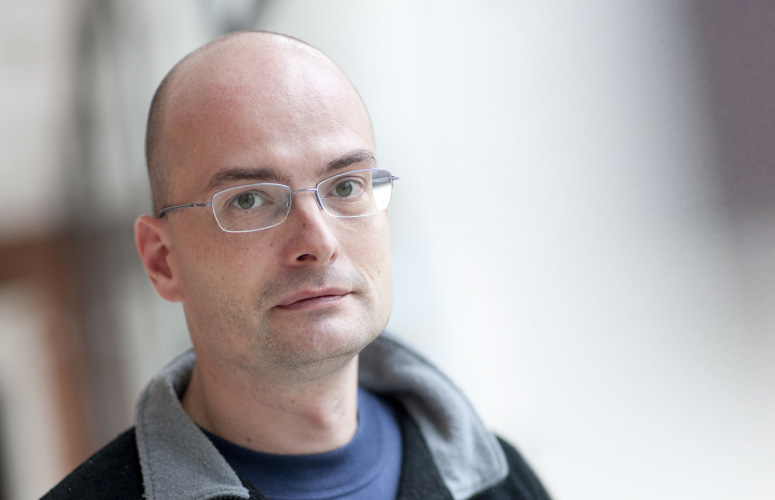Miembros del Departamento de Física Teórica e Historia de la Ciencia de la Facultad de Ciencia y Tecnología de la UPV/EHU, junto con investigadores de la Universidad de Hannover, han logrado en un experimento el entrelazamiento cuántico entre dos nubes de átomos ultrafríos, llamadas condensados de Bose-Einstein, espacialmente separadas entre sí. Esto podrá ayudar al desarrollo de algoritmos cuánticos y llevar a cabo computación cuántica a gran escala. La prestigiosa revista Science publica esta investigación.
Science publica un estudio sobre entrelazamiento cuántico en el que ha participado la UPV/EHU
La UPV/EHU y la Universidad de Hannover logran el entrelazamiento cuántico entre dos nubes de átomos ultrafríos separadas físicamente
Fecha de primera publicación: 27/04/2018

La prestigiosa revista Science se ha hecho eco de un novedoso experimento en el campo de la física cuántica en el que han colaborado varios miembros del grupo de investigación Quantum Information Theory and Quantum Metrology del Departamento de Física Teórica e Historia de la Ciencia de la Facultad de Ciencia y Tecnología de la UPV/EHU, liderados por Géza Tóth, Ikerbasque Research Professor, y llevado a cabo en la Universidad de Hannover. En el experimento, han conseguido el entrelazamiento cuántico entre dos nubes de átomos ultrafríos, conocidos como condensados de Bose-Einstein, donde los dos conjuntos de átomos estaban espacialmente separados entre sí.
El entrelazamiento cuántico fue descubierto por Scrhrödinger y posteriormente estudiado por Einstein y otros científicos en el siglo pasado. Es un fenómeno cuántico que no tiene análogo en la física clásica. Los conjuntos de partículas que están entrelazadas pierden su individualidad y se comportan como una sola entidad. Cualquier cambio en una de las partículas conduce a una respuesta inmediata en la otra, incluso si están espacialmente separadas. “El entrelazamiento cuántico es indispensable en aplicaciones como la computación cuántica, ya que permite la resolución de ciertas tareas de forma mucho más rápida que en computación clásica”, explica Géza Toth, líder del grupo Quantum Information Theory and Quantum Metrology.
A diferencia de la forma en que se ha creado hasta ahora el entrelazamiento cuántico entre nubes de partículas, utilizando conjuntos de partículas incoherentes y térmicas, en este experimento utilizaron conjuntos de átomos en estado de condensado de Bose-Einstein. Tal como explica Toth, “los condensados de Bose-Einstein se consiguen al enfriar los átomos utilizados a temperaturas muy bajas, cercanas al cero absoluto. A esa temperatura, todos los átomos comparten el mismo estado cuántico, con gran coherencia; se podría decir que todos ocupan la misma posición en el espacio. En ese estado se da el entrelazamiento cuántico entre los átomos del conjunto”. Posteriormente, lo que hicieron fue separar en dos nubes de átomos ese conjunto. “Dejamos una distancia entre las dos nubes de átomos, y pudimos demostrar que seguía habiendo entrelazamiento cuántico entre ellas”, continúa.
La demostración de que se puede crear el entrelazamiento entre dos nubes en estado de condensado de Bose-Einstein puede dar lugar a una mejora en muchos campos en los que se utiliza la tecnología cuántica, como la computación cuántica, la simulación cuántica y metrología cuántica, dado que estas requieren de la creación y el control de un gran número de conjuntos de partículas entrelazadas. “La ventaja que ofrecen los átomos ultra fríos es que se pueden conseguir estados fuertemente entrelazados que contienen cantidades de partículas superiores en varios órdenes de magnitud a otros sistemas físicos, lo cual podrá ser la base para la computación cuántica a gran escala”, relata el investigador.
Información complementaria
El experimento se ha llevado a cabo en la Universidad de Hannover por Carsten Klempt y los miembros de su grupo Karsten Lange, Jan Peise, Bernd Lücke e Ilka Kruse. El grupo de Géza Tóth del Departamento de Física Teórica e Historia de la Ciencia de la UPV/EHU lo completan Giuseppe Vitagliano, Iagoba Apellaniz y Matthias Kleinmann, los cuales han desarrollado un criterio que verificaba la presencia del entrelazamiento cuántico.
Referencia bibliográfica
- Entanglement between two spatially separated atomic modes
- Science (2018)
- DOI: 10.1126/science.aao2035








